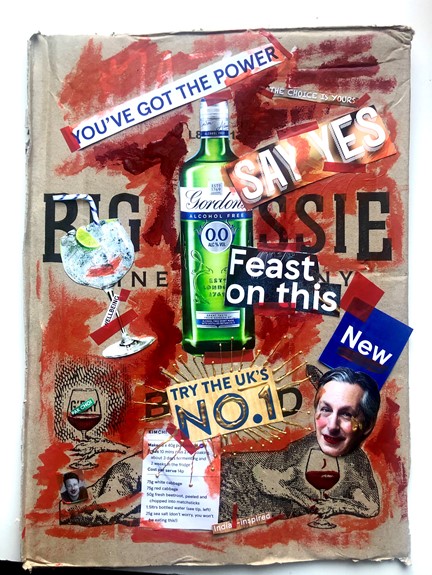Ella Matza

The UK’s No.1, Acrylic paint, duct tape, and Tesco magazine cut-outs on a piece of cardboard from a package
I titled this collage “The UK’s No.1” in order to highlight how the UK has gained success by positioning itself on the backs of others. The top half of the piece emphasises the implied power and choices of the consumer, highlighting the magazine’s use of terms like ‘you’ve got the power’ and ‘the choice is yours’. In contrast, the bottom half reflects terms, recipes and ingredients from Asia which are written in much smaller text, and disappear into the background while the ‘try the UK’s no.1’ cut-out is gilded and centered. I was particularly struck by the irony of tesco’s ‘Kimchi’ recipe that uses zero of the traditional Korean ingredients that make Kimchi what it is. This perfectly exemplifies the cultural erasure, appropriation and fetishisation of the exotic that remains everywhere in British neocolonial culture. Kimchi is extremely significant to Korean culture and Korean immigrants have often been shamed for its fermented smell, but British chefs succeed in gaining success by ignoring the cultural history of this dish and modifying it for the benefit of a western audience. Likewise, the positioning of the gilded UK above Asian foods prompts us to ask who is doing the labor before Tesco products reach consumers? Who created these “exotic” recipes hundreds of years before Jamie Oliver presented them as his own in Tesco magazine? While Tesco has a net worth of 21.06 billion pounds, the cultures that they steal from often do not have the British consumer’s ‘choice’ or ‘power’.
I have chosen to place the collage on top of a ‘Big Aussie’ wine box. Alcohol has a long colonial history, and the language we use today still reflects this. Wine was one of many products that Europeans brought to indigenous societies with the assumption that the European product would be irresistible, as it was the product of a superior society. Today, ‘Old World’ wines are primarily from countries that colonized (France, Italy, Spain), while ‘New World’ wines tend to come from their colonies (the US, South Africa, Australia). Likewise, the bottle of gin that features prominently in this collage has colonial roots in British India. The British East India Company created the ‘Gin and Tonic’ with the belief that quinine in tonic cured malaria, and thus it was given to British soldiers (and no one else) as a medical cocktail. While Tesco wants to push the message that “the choice is yours”, the act of choosing a recipe or an alcoholic beverage is never benign. Rather, it is one small contribution to a complex web of history, economic dependency, and cultural transformation.
Click Below to Return to the Curation Front Page:
